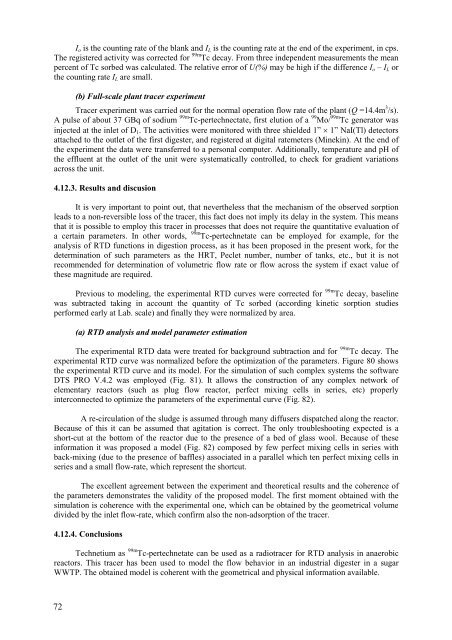Download file - Ayuntamiento de Zaragoza
Download file - Ayuntamiento de Zaragoza
Download file - Ayuntamiento de Zaragoza
Create successful ePaper yourself
Turn your PDF publications into a flip-book with our unique Google optimized e-Paper software.
I o is the counting rate of the blank and I L is the counting rate at the end of the experiment, in cps.The registered activity was corrected for 99m Tc <strong>de</strong>cay. From three in<strong>de</strong>pen<strong>de</strong>nt measurements the meanpercent of Tc sorbed was calculated. The relative error of U(%) may be high if the difference I o – I L orthe counting rate I L are small.(b) Full-scale plant tracer experimentTracer experiment was carried out for the normal operation flow rate of the plant (Q =14.4m 3 /s).A pulse of about 37 GBq of sodium 99m Tc-pertechnectate, first elution of a 99 Mo/ 99m Tc generator wasinjected at the inlet of D 1 . The activities were monitored with three shiel<strong>de</strong>d 1” × 1” NaI(Tl) <strong>de</strong>tectorsattached to the outlet of the first digester, and registered at digital ratemeters (Minekin). At the end ofthe experiment the data were transferred to a personal computer. Additionally, temperature and pH ofthe effluent at the outlet of the unit were systematically controlled, to check for gradient variationsacross the unit.4.12.3. Results and discusionIt is very important to point out, that nevertheless that the mechanism of the observed sorptionleads to a non-reversible loss of the tracer, this fact does not imply its <strong>de</strong>lay in the system. This meansthat it is possible to employ this tracer in processes that does not require the quantitative evaluation ofa certain parameters. In other words, 99m Tc-pertechnetate can be employed for example, for theanalysis of RTD functions in digestion process, as it has been proposed in the present work, for the<strong>de</strong>termination of such parameters as the HRT, Peclet number, number of tanks, etc., but it is notrecommen<strong>de</strong>d for <strong>de</strong>termination of volumetric flow rate or flow across the system if exact value ofthese magnitu<strong>de</strong> are required.Previous to mo<strong>de</strong>ling, the experimental RTD curves were corrected for 99m Tc <strong>de</strong>cay, baselinewas subtracted taking in account the quantity of Tc sorbed (according kinetic sorption studiesperformed early at Lab. scale) and finally they were normalized by area.(a) RTD analysis and mo<strong>de</strong>l parameter estimationThe experimental RTD data were treated for background subtraction and for 99m Tc <strong>de</strong>cay. Theexperimental RTD curve was normalized before the optimization of the parameters. Figure 80 showsthe experimental RTD curve and its mo<strong>de</strong>l. For the simulation of such complex systems the softwareDTS PRO V.4.2 was employed (Fig. 81). It allows the construction of any complex network ofelementary reactors (such as plug flow reactor, perfect mixing cells in series, etc) properlyinterconnected to optimize the parameters of the experimental curve (Fig. 82).A re-circulation of the sludge is assumed through many diffusers dispatched along the reactor.Because of this it can be assumed that agitation is correct. The only troubleshooting expected is ashort-cut at the bottom of the reactor due to the presence of a bed of glass wool. Because of theseinformation it was proposed a mo<strong>de</strong>l (Fig. 82) composed by few perfect mixing cells in series withback-mixing (due to the presence of baffles) associated in a parallel which ten perfect mixing cells inseries and a small flow-rate, which represent the shortcut.The excellent agreement between the experiment and theoretical results and the coherence ofthe parameters <strong>de</strong>monstrates the validity of the proposed mo<strong>de</strong>l. The first moment obtained with thesimulation is coherence with the experimental one, which can be obtained by the geometrical volumedivi<strong>de</strong>d by the inlet flow-rate, which confirm also the non-adsorption of the tracer.4.12.4. ConclusionsTechnetium as 99m Tc-pertechnetate can be used as a radiotracer for RTD analysis in anaerobicreactors. This tracer has been used to mo<strong>de</strong>l the flow behavior in an industrial digester in a sugarWWTP. The obtained mo<strong>de</strong>l is coherent with the geometrical and physical information available.72
















